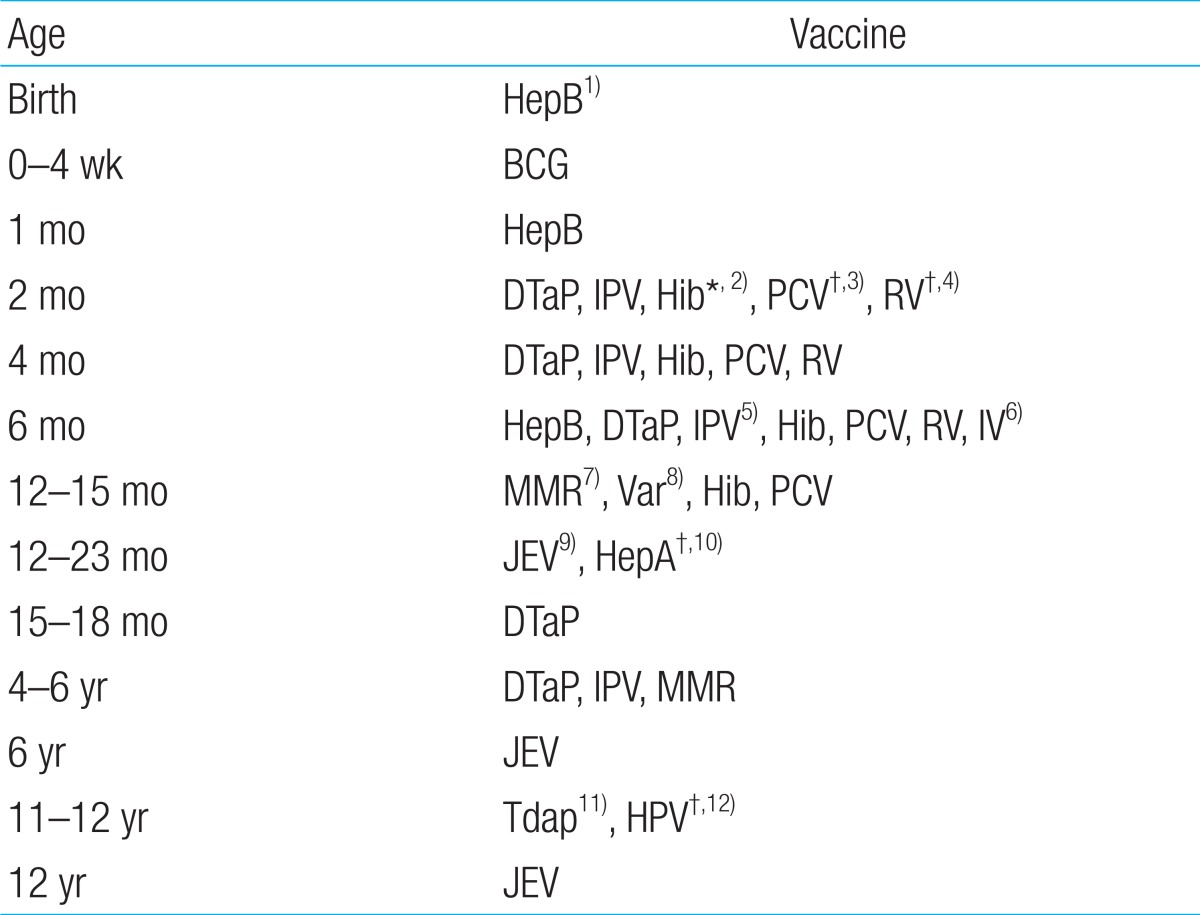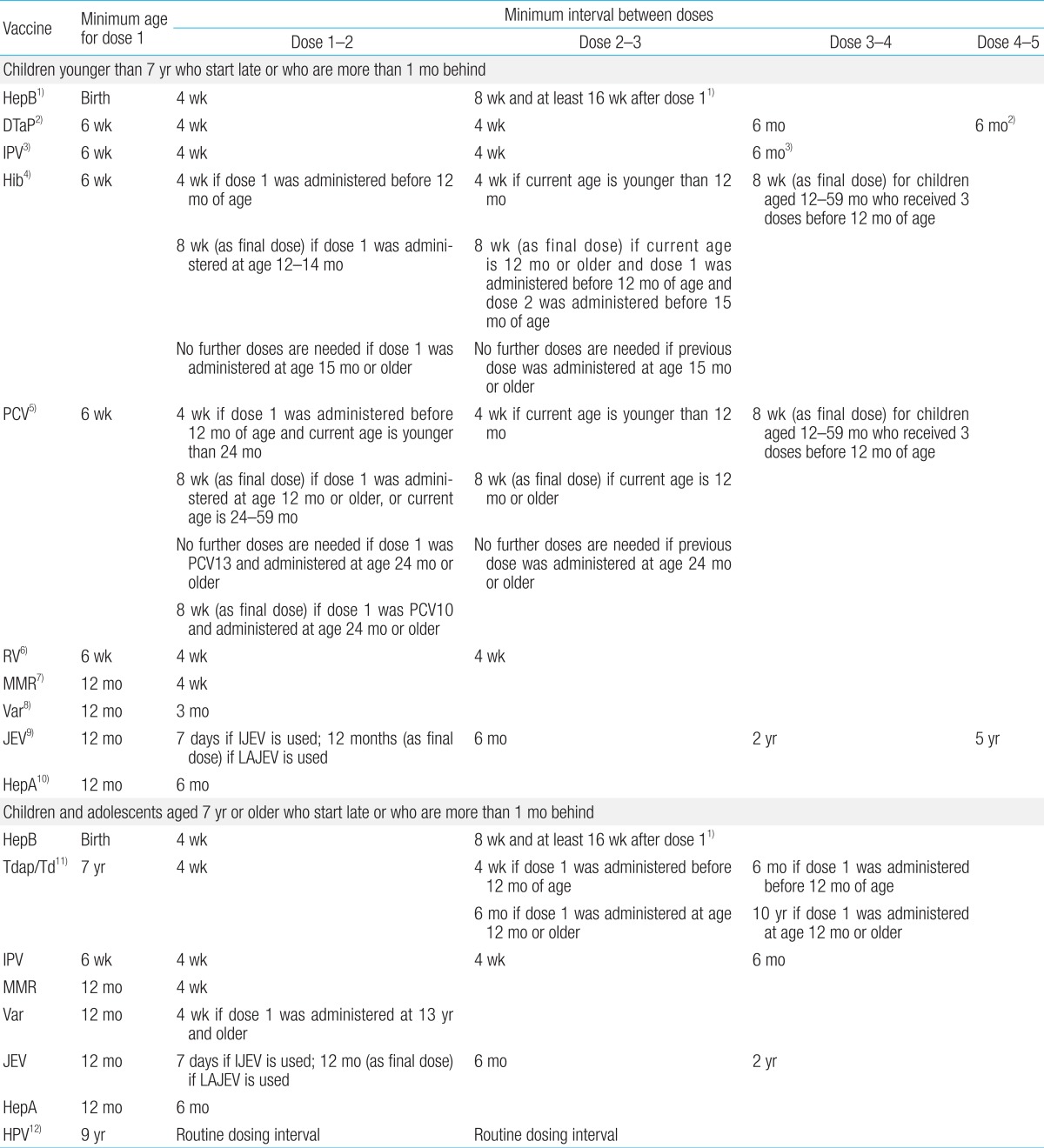< Previous Next >
Article Contents
| Korean J Pediatr > Volume 56(6); 2013 |
Abstract
Table┬Ā1

BCG, bacille Calmette-Gu├®rin; DTaP, diphtheria and tetanus toxoids and acellular pertussis vaccine; HepA, hepatitis A vaccine; HepB, hepatitis B vaccine; Hib, Haemophilus influenzae type b vaccine; HPV, human papilloma virus vaccine; IPV, inactivated polio vaccine; IV, influenza vaccine; JEV, Japanese encephalitis vaccine; MMR, measles, mumps, and rubella vaccine; PCV, pneumococcal conjugate vaccine; RV, rotavirus vaccine; Tdap, tetanus and diphtheria toxoids and acellular pertussis vaccine; Var, varicella vaccine.
*Hib is now covered by the National Immunization Program of Korea as of March 2013. ŌĆĀPCV, RV, HepA, and HPV are optional vaccines, which are recommended to all children and adolescents, but parents or guardians may make decision of administration.
-
HepB: Administer HepB at 0, 1, and 6 months of age according to the maternal hepatitis B surface antigen (HBsAg) status as follows.
If maternal HBsAg is positive, administer HepB and 0.5 mL of hepatitis B immune globulin (HBIG) within 12 hours of birth at different sites.
If maternal HBsAg status is unknown, administer HepB within 12 hours of birth and test maternal HBsAg status as soon as possible, and if the result is positive, administer HBIG as soon as possible, no later than 7 days of birth.
If maternal HBsAg is negative, start HepB series no later than 2 months of age, preferably before hospital discharge.
Hib: Primary series doses of Hib are at 2, 4, and 6 months of age; however, for PRP-OMP, a dose at 6 months is not required if it was administered at 2 and 4 months of age. Administer a booster dose of Hib at 12-15 months of age.
PCV: Primary series of PCV are at 2, 4, and 6 months of age and a booster dose is at 12-15 months of age. If the first dose is administered after 6 months of age, the total number of doses may vary 1 through 3 according to the age of the first dose.
RV: Administer either Rotarix (GSK) at 2 and 4 months of age or RotaTeq (MSD) at 2, 4, and 6 months of age. The first dose of any RV can be administered as early as 6 weeks of age but no later than 14 weeks 6 days. The minimal interval between any doses is 4 weeks, and the final dose should be administered no later than 8 month 0 days for both vaccines.
IPV: The third dose of IPV may be administered at age 6-18 months.
IV: Administer IV every year to all children aged 6-59 months, caregivers and family members of children aged 0-59 months, children and adolescents 5 years and older who have any underlying medical conditions predisposing them to influenza infection, their caregivers, and persons who want IV. Administer 1 dose to children and adolescents aged 9 years and older; administer 2 doses with an interval of 4 weeks or more to children younger than 9 years who are receiving IV for the first time and to children younger than 9 years who received only the first dose but not the second dose last year. If inactivated IV (IIV) is used, administer 0.25 mL of IIV intramuscularly to vaccinees aged 6-35 months and 0.5 mL of IIV to those aged 3 years and older. Live attenuated IV (LAIV) is approved for persons aged 2 years and older; if LAIV is used, administer 0.2 mL of LAIV intranasally.
MMR: The first dose should be administered at age 12 through 15 months and the second dose at age 4-6 years. The second dose may be administered before age 4 years with an interval 4 weeks or more from the first dose. When an outbreak of measles occurs in the community, a dose of measles vaccine or measles containing vaccine, such as MMR, can be administered to infants aged 6-11 months; these children should be revaccinated with 2 doses of MMR, i.e., the first at age 12-15 months, and the second at age 4-6 years.
Var: Administer all children a single dose of Var at age 12-15 months. Second dose of Var may be administered to children aged 15 months to 12 years who attend day-care centers, schools, or facilities where chicken pox is prevalent, provided at least 3 months have elapsed since the first dose. For adolescents aged 13 and older without evidence of immunity, two doses of Var are indicated with a minimum interval of 4 weeks.
JEV: Administer either inactivated JEV (IJEV) series or live attenuated JEV (LAJEV) series. If IJEV is used, administer the first dose at age 12-23 months and the second dose 7-30 days later. Administer the third dose of IJEV next year with a minimal interval of 6 months from the second dose. Administer booster doses, i.e., the fourth and the fifth doses, at ages 6 and 12 years, respectively. Administer 0.5 mL to children younger than 3 years and 1.0 mL to those aged 3 years and older. If LAJEV is used, administer the first dose at age 12-23 months and the second dose at least 12 months later.
HepA: Administer the first dose to children aged 12 months and older and the second dose 6-18 months later according to the instruction of each HepA product.
Tdap: Administer one dose of Tdap to adolescents aged 11-12 years, and administer Tetanus and diphtheria toxoids (Td) 10 years later. To adolescents aged 11-18 years with a history of Td but no Tdap, administer one dose of Tdap regardless of the interval since the last Td vaccination, and administer Td 10 years later.
HPV: Administer the first dose of either Cervarix (GSK) or Gardasil (MSD) to females aged 11-12 years. Administer the second dose one month (Cervarix) or two months (Gardasil) after the first dose and the third dose 6 months after the first dose for both vaccines.
Table┬Ā2

HepB, hepatitis B vaccine; DTaP, diphtheria and tetanus toxoids and acellular pertussis vaccine; IPV, inactivated polio vaccine; Hib, Haemophilus influenzae type b vaccine; PCV, pneumococcal conjugate vaccine; RV, rotavirus vaccine; MMR, measles, mumps, and rubella vaccine; Var, varicella vaccine; JEV, Japanese encephalitis vaccine; HepA, hepatitis A vaccine; Tdap, tetanus and diphtheria toxoids and acellular pertussis vaccine; HPV, human papilloma virus vaccine.
HepB: Administer a complete series of HepB to persons who have no history of HepB immunization. The third dose should be administered no earlier than age of 24 weeks, and at least 16 weeks after the first dose.
DTaP: The fifth dose is not required if the fourth dose was administered at age 4 years or older.
IPV: Before the age of 6 months, routine dosing interval is generally recommended, except for the infants who are at risk for imminent exposure to circulating poliovirus, only for whom minimum age and minimum intervals are recommended. Last dose should be administered no earlier than age of 4 years with an interval of 6 months or longer after the previous dose. The fourth dose is not required if the third dose was administered at age 4 years or older and at least 6 months after dose 2. The fourth dose is required, however, if both oral polio vaccine and IPV were administered as part of the previous 3 doses.
Hib: To children who received the first two doses with PRP-OMP before age 12 months, administer the third dose as final dose at age 12-15 months with a minimum interval of 8 weeks from the second dose. Hib is not routinely recommended for children at age 60 months or older. See Chapter 14. Haemophilus influenzae type b vaccine in the KPS Immunization Guideline, 2012 for further details.
PCV: PCV is not routinely recommended for children at age 60 months or older, except who have certain underlying medical conditions. See Chapter 15. Streptococcus pneumoniae vaccine in the KPS Immunization Guideline, 2012 for further details.
RV: The first dose of RV should be administered no later than 14 weeks 6 days, i.e., the vaccination should not be initiated for infants at age 15 weeks 0 days or older. The final dose should be administered no later than 8 months 0 days.
MMR: The second dose is routinely administered at age 4-6 years. If needed, however, it may be administered before age 4 years with an interval 4 weeks or more from the first dose.
Var: Administer all children a single dose of Var at age 12-15 months. Second dose of Var may be administered to children aged 15 months through 12 years who attend day-care centers, schools, or facilities where chickenpox is prevalent, provided at least 3 months have elapsed since the first dose. For adolescents aged 13 and older without evidence of immunity, two doses of Var are indicated with a minimum interval of 4 weeks.
JEV: If the third dose of inactivated JEV (IJEV) was administered at age 4-9 years, administer the fourth dose as the final dose at age 12 years or older. Fifth dose is not required if the third dose and fourth dose were administered at age 10 years or older. If LAJEV is used, administer 2 doses with a minimum interval of 12 months.
HepA: Administer 2 doses with an interval of 6-18 months according to the instruction of each HepA product.
Tdap/Td: Previous DTaP doses can count as Tdap/Td doses. Children aged 7 years or older who have not completed DTaP series should receive Tdap/Td for catch-up immunization starting with Tdap.
HPV: Administer either series of Cervarix (GSK) or Gardasil (MSD) to females aged 13-18 years who have not previously been vaccinated. Administer the second dose one month (Cervarix) or two months (Gardasil) after the first dose and the third dose 6 months after the first dose for both vaccines.



 PDF Links
PDF Links PubReader
PubReader PubMed
PubMed Download Citation
Download Citation


